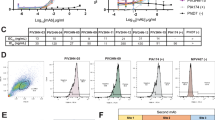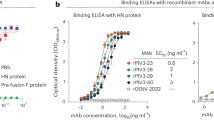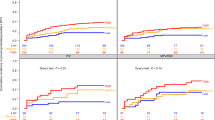Abstract
Parainfluenza virus type 3 (PIV-3) can cause severe respiratory illness among hematopoietic cell transplantation (HCT) recipients. Factors associated with PIV-3-specific Ab level, and the association between PIV-3 Ab levels and clinical outcomes in HCT recipients who acquire PIV-3 infection, are unknown. We evaluated PIV-3-specific hemagglutination inhibition Ab levels and clinical outcomes among 172 patients with PIV-3 infection following HCT. In a multivariable linear regression model, high post-transplantation Ab levels were independently associated with higher pre-transplantation recipient titer (mean difference 0.38 (95% confidence interval (CI), 0.26, 0.50), P<0.001). Significant associations between pre-HCT Ab titers in both patients and donors and occurrence of lower respiratory tract disease (LRD) after HCT were not observed. In conclusion, low pre-transplantation titers are associated with low Ab levels after HCT. The relationship between PIV-3 Ab levels and outcomes remain uncertain. Further study is needed to prospectively evaluate the dynamics of PIV-3-specific Ab responses and the relative contribution of PIV-3-specific Ab to protection from infection acquisition and progression to LRD.
This is a preview of subscription content, access via your institution
Access options
Subscribe to this journal
Receive 12 print issues and online access
$259.00 per year
only $21.58 per issue
Buy this article
- Purchase on SpringerLink
- Instant access to full article PDF
Prices may be subject to local taxes which are calculated during checkout


Similar content being viewed by others
References
Nichols WG, Erdman DD, Han A, Zukerman C, Corey L, Boeckh M . Prolonged outbreak of human parainfluenza virus 3 infection in a stem cell transplant outpatient department: insights from molecular epidemiologic analysis. Biol Blood Marrow Transplant 2004; 10: 58–64.
Maziarz RT, Sridharan P, Slater S, Meyers G, Post M, Erdman DD et al. Control of an outbreak of human parainfluenza virus 3 in hematopoietic stem cell transplant recipients. Biol Blood Marrow Transplant 2010; 16: 192–198.
Hodson A, Kasliwal M, Streetly M, MacMahon E, Raj K . A parainfluenza-3 outbreak in a SCT unit: sepsis with multi-organ failure and multiple co-pathogens are associated with increased mortality. Bone Marrow Transplant 2011; 46: 1545–1550.
Sydnor ER, Greer A, Budd AP, Pehar M, Munshaw S, Neofytos D et al. An outbreak of human parainfluenza virus 3 infection in an outpatient hematopoietic stem cell transplantation clinic. Am J Infect Control 2012; 40: 601–605.
Cortez KJ, Erdman DD, Peret TC, Gill VJ, Childs R, Barrett AJ et al. Outbreak of human parainfluenza virus 3 infections in a hematopoietic stem cell transplant population. J Infect Dis 2001; 184: 1093–1097.
Jalal H, Bibby DF, Bennett J, Sampson RE, Brink NS, MacKinnon S et al. Molecular investigations of an outbreak of parainfluenza virus type 3 and respiratory syncytial virus infections in a hematology unit. J Clin Microbiol 2007; 45: 1690–1696.
Seo S, Xie H, Campbell AP, Kuypers JM, Leisenring WM, Englund JA et al. Parainfluenza virus lower respiratory tract disease after hematopoietic cell transplantation: viral detection in the lung predicts outcome. Clin Infect Dis 2014; 58: 1357–1368.
Ustun C, Slaby J, Shanley RM, Vydra J, Smith AR, Wagner JE et al. Human parainfluenza virus infection after hematopoietic stem cell transplantation: risk factors, management, mortality, and changes over time. Bio Blood Marrow Transplant 2012; 18: 1580–1588.
Chemaly RF, Hanmod SS, Rathod DB, Ghantoji SS, Jiang Y, Doshi A et al. The characteristics and outcomes of parainfluenza virus infections in 200 patients with leukemia or recipients of hematopoietic stem cell transplantation. Blood 2012; 119: 2738–2745 quiz 2969.
Srinivasan A, Wang C, Yang J, Shenep JL, Leung WH, Hayden RT . Symptomatic parainfluenza virus infections in children undergoing hematopoietic stem cell transplantation. Bio Blood Marrow Transplant 2011; 17: 1520–1527.
Nichols WG, Corey L, Gooley T, Davis C, Boeckh M . Parainfluenza virus infections after hematopoietic stem cell transplantation: risk factors, response to antiviral therapy, and effect on transplant outcome. Blood 2001; 98: 573–578.
Elizaga J, Olavarria E, Apperley J, Goldman J, Ward K . Parainfluenza virus 3 infection after stem cell transplant: relevance to outcome of rapid diagnosis and ribavirin treatment. Clin Infect Dis 2001; 32: 413–418.
Lewis VA, Champlin R, Englund J, Couch R, Goodrich JM, Rolston K et al. Respiratory disease due to parainfluenza virus in adult bone marrow transplant recipients. Clin Infect Dis 1996; 23: 1033–1037.
Schiffer JT, Kirby K, Sandmaier B, Storb R, Corey L, Boeckh M . Timing and severity of community acquired respiratory virus infections after myeloablative versus non-myeloablative hematopoietic stem cell transplantation. Haematologica 2009; 94: 1101–1108.
Chakrabarti S, Avivi I, Mackinnon S, Ward K, Kottaridis PD, Osman H et al. Respiratory virus infections in transplant recipients after reduced-intensity conditioning with Campath-1H: high incidence but low mortality. Br J Haematol 2002; 119: 1125–1132.
Storek J, Dawson MA, Storer B, Stevens-Ayers T, Maloney DG, Marr KA et al. Immune reconstitution after allogeneic marrow transplantation compared with blood stem cell transplantation. Blood 2001; 97: 3380–3389.
Bosch M, Dhadda M, Hoegh-Petersen M, Liu Y, Hagel LM, Podgorny P et al. Immune reconstitution after anti-thymocyte globulin-conditioned hematopoietic cell transplantation. Cytotherapy 2012; 14: 1258–1275.
Falsey AR, Walsh EE . Relationship of serum antibody to risk of respiratory syncytial virus infection in elderly adults. J Infect Dis 1998; 177: 463–466.
Luchsinger V, Piedra PA, Ruiz M, Zunino E, Martinez MA, Machado C et al. Role of neutralizing antibodies in adults with community-acquired pneumonia by respiratory syncytial virus. Clin Infect Dis 2012; 54: 905–912.
Walsh EE, Peterson DR, Falsey AR . Risk factors for severe respiratory syncytial virus infection in elderly persons. J Infect Dis 2004; 189: 233–238.
Piedra PA, Jewell AM, Cron SG, Atmar RL, Glezen WP . Correlates of immunity to respiratory syncytial virus (RSV) associated-hospitalization: establishment of minimum protective threshold levels of serum neutralizing antibodies. Vaccine 2003; 21: 3479–3482.
The IMpact-RSV Study Group. Palivizumab, a humanized respiratory syncytial virus monoclonal antibody, reduces hospitalization from respiratory syncytial virus infection in high-risk infants. Pediatrics 1998; 102 (3 Pt 1): 531–537.
Glezen WP, Frank AL, Taber LH, Kasel JA . Parainfluenza virus type 3: seasonality and risk of infection and reinfection in young children. J Infect Dis 1984; 150: 851–857.
Kasel JA, Frank AL, Keitel WA, Taber LH, Glezen WP . Acquisition of serum antibodies to specific viral glycoproteins of parainfluenza virus 3 in children. J Virol 1984; 52: 828–832.
Glezen WP, Denny FW . Parainfluenza viruses. In: AS Evans, RA Kaslow (eds). Viral Infections of Humans 1997.
Henrickson KJ . Parainfluenza viruses. Clin Microbiol Rev 2003; 16: 242–264.
Moscona A . Entry of parainfluenza virus into cells as a target for interrupting childhood respiratory disease. J Clin Invest 2005; 115: 1688–1698.
Seo S, Campbell AP, Xie H, Chien JW, Leisenring WM, Englund JA et al. Outcome of respiratory syncytial virus lower respiratory tract disease in hematopoietic cell transplant recipients receiving aerosolized ribavirin: significance of stem cell source and oxygen requirement. Biol Blood Marrow Transplant 2013; 19: 589–596.
Clements ML, Belshe RB, King J, Newman F, Westblom TU, Tierney EL et al. Evaluation of bovine, cold-adapted human, and wild-type human parainfluenza type 3 viruses in adult volunteers and in chimpanzees. J Clin Microbiol 1991; 29: 1175–1182.
Karron RA, Thumar B, Schappell E, Surman S, Murphy BR, Collins PL et al. Evaluation of two chimeric bovine-human parainfluenza virus type 3 vaccines in infants and young children. Vaccine 2012; 30: 3975–3981.
Bosch M, Khan FM, Storek J . Immune reconstitution after hematopoietic cell transplantation. Curr Opin Hematol 2012; 19: 324–335.
Kim YJ, Guthrie KA, Waghmare A, Walsh EE, Falsey AR, Kuypers J et al. Respiratory syncytial virus in hematopoietic cell transplant recipients: factors determining progression to lower respiratory tract disease. J Infect Dis 2014; 209: 1195–1204.
Acknowledgements
We thank Chris Davis, George Counts and Zachary Stednick for data management, Tera Matson, Elsa Garnace and Jessica Yi for laboratory assistance, and Ikuyo Imayama for statistical advice. This work was partially supported by NIH grants CA18029, CA15704, HL081595, HL93294, K23HL091059 and L40AI071572. SS is a recipient of a fellowship from the Joel Meyers Memorial Fund. APC also received support from the Seattle Children’s Center for Clinical and Translational Research and CTSA grant ULI RR025014.
Author information
Authors and Affiliations
Corresponding author
Ethics declarations
Competing interests
MB and SS received research support from Ansun Biopharma. The remaining authors declare no conflict of interest.
Additional information
Supplementary Information accompanies this paper on Bone Marrow Transplantation website
Supplementary information
Rights and permissions
About this article
Cite this article
Seo, S., Xie, H., Karron, R. et al. Parainfluenza virus type 3 Ab in allogeneic hematopoietic cell transplant recipients: factors influencing post-transplant Ab titers and associated outcomes. Bone Marrow Transplant 49, 1205–1211 (2014). https://doi.org/10.1038/bmt.2014.124
Received:
Revised:
Accepted:
Published:
Issue date:
DOI: https://doi.org/10.1038/bmt.2014.124



